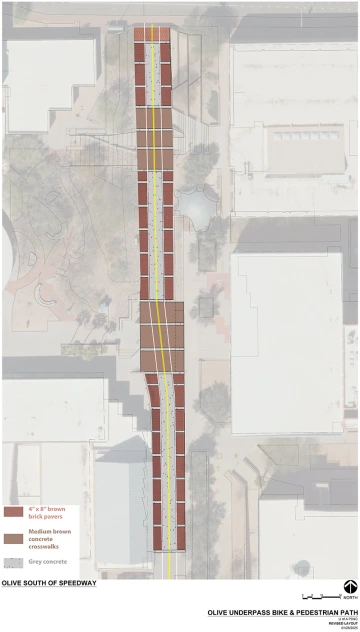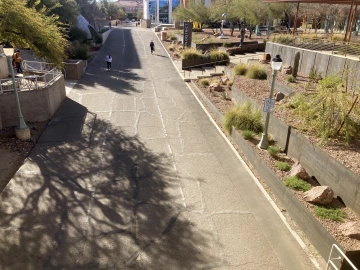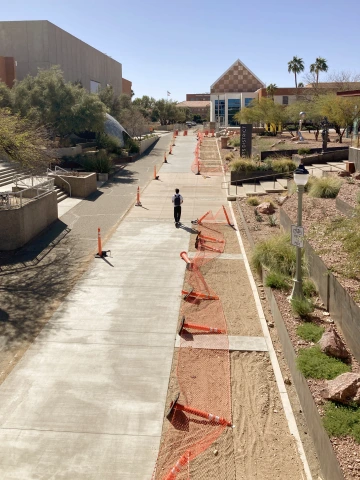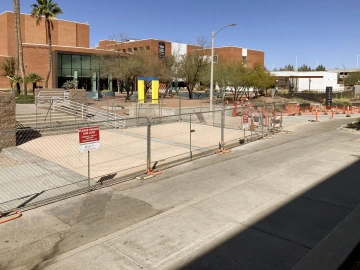
Paving plan for Olive Street Underpass, south approach
The bike and pedestrian paths south of the Olive Street Underpass are getting a much-needed facelift that will more closely match the approach on the north side of the overpass. The cracked and weathered asphalt pavement is being replaced to improve the aesthetics and surface textures and create a more durable distinction between bike and pedestrian lanes. It will also blend better with the surrounding landscape and hardscape.
The pedestrian path pavement on each side of the bike path is hand-lain brown brick pavers with concrete cross-bands to provide visual breaks and structural reinforcement to prevent shifting of the pedestrian-path pavers on the sloped surface. The bike lane is paved in gray concrete, to distinguish it from the pedestrian lanes and to provide a suitable surface for bikes, skateboards, scooters etc. The color contrast will make the lane separations more pronounced for safety.
Two wide brown-concrete crosswalks connect Creative Photography and Architecture building stairs on the east side to the Arts Plaza on the west side. The brown concrete provides a durable visual distinction from the gray concrete bike lane, which will make it safer for pedestrians to cross the bike lane.
The repaving project is being performed by the UFS Masonry Shop, with completion projected by the end of May 2025. The new pavement includes approximately 5,500 square feet of brown pavers (24,750 hand-lain pavers), 3,500 square feet of brown concrete crosswalks, and 5,000 square feet of gray concrete bike lanes and cross-bands.
The project has been staged to maintain pedestrian and “walk your bike” underpass access throughout the project.
Image

The original condition of the pavement on the south approach to the Olive Street Underpass. The asphalt was cracked and weathered, producing a rough surface for foot and bicycle traffic. Lane markings were faded and damaged, blurring the distinction between bicycle and pedestrian paths. There were also no crosswalks marked along the path. Mark Marikos | Image

This south-facing view shows the concrete poured for the bicycle path, and the cross-bands that will separate sections of pavers forming the west pedestrian path. Two partially completed brown concrete crosswalks will connect the Architecture and Creative Photography entrance stairs, east of the path, to the Arts Plaza west of the path. The asphalt strip to the left will become the east pedestrian path, and was left open to pedestrian traffic during construction of the bicycle path and west pedestrian path Mark Marikos |
Image

The central and west portions of the south crosswalk that will connect the Creative Photography entrance (out of view to the right) stairs to the Arts Plaza on the left. The remnant of the original asphalt pavement was left intact during the first phase to allow pedestrian traffic. | Image

Westward view of the central and west sections of the crosswalk connecting the Architecture Building entrance stairs (foreground) to the Arts Plaza (background). Mark Marikos |

